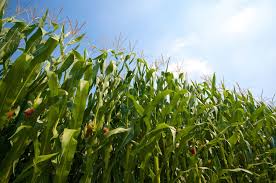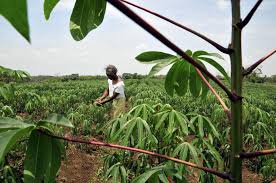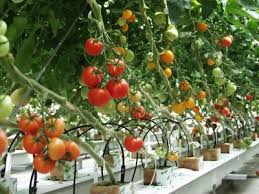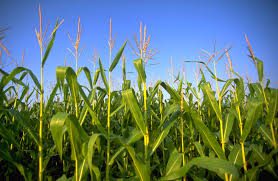Crop improvement is a crucial aspect of agricultural science that aims to enhance the quality and yield of crops. As the global population continues to rise, the demand for food is increasing, necessitating the need for more efficient and productive agricultural practices.
Crop improvement involves the use of various techniques to develop new plant varieties that can withstand pests, diseases, and environmental stresses while maximizing yields. This process is vital for ensuring food security and sustainability in agriculture.
Historically, crop improvement began with traditional methods such as selective breeding. Farmers would select plants with desirable traits, such as higher yields or better taste, to breed the next generation.
This practice laid the foundation for modern agricultural practices, where scientists now employ advanced techniques to achieve more significant results.
The development of hybrid crops, for instance, has led to increased productivity and resilience in various environments. Hybrids are produced by crossing two different parent varieties to produce offspring that exhibit superior qualities.
With the advent of molecular biology and biotechnology, crop improvement has taken a revolutionary turn. Techniques like genetic engineering allow for the direct manipulation of an organism’s genes, leading to the creation of genetically modified organisms (GMOs).
These crops can be engineered to exhibit traits such as herbicide resistance, improved nutritional content, or enhanced resistance to environmental stresses like drought or salinity.
For example, Bt cotton is genetically modified to produce a toxin that deters certain pests, reducing the need for chemical insecticides and benefiting both the environment and farmers’ profits.
Another essential aspect of crop improvement is the focus on sustainable practices. As climate change and environmental degradation pose significant challenges to agriculture, researchers are increasingly looking for ways to develop crops that can thrive in changing conditions.
This includes breeding varieties that require fewer inputs, such as water and fertilizers, thereby minimizing the environmental impact of farming. Efforts to develop drought-resistant and salt-tolerant crops are particularly critical in regions where water scarcity is a growing concern.
In addition to enhancing yield and resilience, crop improvement also plays a role in addressing nutritional deficiencies. Many developing countries face challenges related to malnutrition, and biofortification is one strategy to combat this issue.
This approach involves increasing the nutrient content of staple crops, such as rice or maize, to improve public health outcomes. Crops enriched with essential vitamins and minerals can help alleviate nutrient deficiencies in populations that rely heavily on these foods.
The importance of crop improvement extends beyond individual farms; it has significant implications for global food security, rural economies, and environmental sustainability. As the agricultural sector strives to meet the food needs of a growing population, ongoing research and innovation in crop improvement will be essential.
The integration of traditional breeding methods with modern biotechnology, along with a focus on sustainable practices, holds the key to creating resilient crops that can adapt to future challenges.
Crop improvement is a multifaceted field that encompasses various techniques aimed at enhancing crop quality, yield, and sustainability. As agriculture faces unprecedented challenges, the continued advancement in crop improvement will be vital for ensuring a secure and sustainable food supply for generations to come.
Here’s an article on the Importance of Crop Improvement in Agriculture, covering its historical background, goals, and types of methods used.
Importance of Crop Improvement in Agriculture

Crop improvement is crucial for several reasons:
1. Increased Food Production: Improving crop varieties leads to higher yields, which is essential for feeding the growing global population.
2. Disease and Pest Resistance: Crop improvement focuses on developing varieties resistant to diseases and pests, reducing the need for chemical inputs and minimizing crop losses.
3. Environmental Sustainability: Improved crop varieties can be more resilient to environmental stresses, such as drought or poor soil conditions, promoting sustainable agricultural practices.
4. Economic Benefits: Higher yields and better-quality crops can increase farmers’ incomes and contribute to the overall economy.
5. Adaptation to Climate Change: Crop improvement plays a critical role in developing varieties that can thrive in changing climate conditions, ensuring food security in the future.
Historical Background of Crop Improvement
The history of crop improvement dates back thousands of years, with early agricultural practices laying the foundation for modern techniques. Here’s a brief overview:
1. Ancient Practices: Early humans began selecting and cultivating wild plants for desirable traits, such as size and taste, leading to the domestication of staple crops.
2. Traditional Breeding: As civilizations advanced, farmers engaged in traditional breeding practices, cross-pollinating plants to create improved varieties.
3. Scientific Advances: The 19th and 20th centuries saw significant advancements in genetics, leading to a better understanding of inheritance and traits. Gregor Mendel’s experiments with pea plants laid the groundwork for modern genetics.
4. Green Revolution: In the mid-20th century, the Green Revolution introduced high-yielding varieties of crops, particularly wheat and rice, which significantly increased food production in developing countries.
5. Biotechnology Era: The late 20th and early 21st centuries marked the rise of biotechnology, enabling genetic modifications and advancements in molecular breeding techniques.
Goals of Crop Improvement Programs
Crop improvement programs are designed to achieve specific goals that enhance agricultural productivity and sustainability. Here are some primary objectives:
1. Yield Enhancement: The primary goal is to develop high-yielding crop varieties that can produce more food per acre.
2. Quality Improvement: Programs aim to enhance the nutritional value, taste, and appearance of crops, making them more appealing to consumers.
3. Resistance Development: Creating varieties that resist pests, diseases, and environmental stresses is crucial for reducing crop losses and improving resilience.
4. Stress Tolerance: Developing crops that can withstand abiotic stresses, such as drought, salinity, and extreme temperatures, is essential for adapting to climate change.
5. Farmer Preferences: Crop improvement programs consider the preferences and needs of farmers, ensuring that the developed varieties are suitable for local growing conditions and market demands.
Read Also: 17 Medicinal Health Benefits Of Strobilanthes callosa (Neelakurinji)
Types of Crop Improvement Methods

Several methods are employed in crop improvement, each with its advantages and limitations. Here are the main types:
1. Traditional Breeding: This method involves selecting parent plants with desirable traits and crossing them to produce new varieties. It relies on natural genetic variation and takes several generations to achieve results.
2. Hybridization: Hybrid crops are produced by crossing two genetically different parent varieties. Hybrids often exhibit improved yield and vigor, known as hybrid vigor or heterosis.
3. Genetic Engineering: This advanced method involves directly altering the plant’s genetic material using biotechnology. Genetic engineering allows for the introduction of specific traits, such as pest resistance or enhanced nutritional content.
4. Marker-Assisted Selection (MAS): MAS uses molecular markers to identify desirable traits in plants. This method speeds up the breeding process by allowing breeders to select plants with specific genetic markers associated with desired traits.
5. Tissue Culture: This technique involves growing plant cells or tissues in a controlled environment to produce clones of a plant. Tissue culture is useful for producing disease-free plants and for breeding programs that require rapid multiplication.
Genetic Basis of Crop Improvement
The genetic basis of crop improvement relies on understanding how traits are inherited and expressed in plants. Here are key concepts:
1. Genes and Alleles: Genes are segments of DNA that code for specific traits. Alleles are different versions of a gene that can lead to variations in these traits.
2. Genetic Variation: Genetic variation is essential for crop improvement as it provides the raw material for selection. This variation can arise naturally through mutations or be introduced through breeding techniques.
3. Phenotypes and Genotypes: The phenotype is the observable expression of traits, while the genotype is the genetic makeup of an organism. Understanding the relationship between genotype and phenotype is crucial for breeding.
4. Heritability: Heritability is the measure of how much of a trait’s variation is due to genetic factors. Traits with high heritability are more likely to be passed on to the next generation, making them suitable targets for breeding.
Conventional Breeding Techniques
Conventional breeding techniques have been used for centuries to improve crops. These methods rely on natural genetic variation and selective breeding:
1. Selection: Farmers select plants with desirable traits for reproduction. This process can be done through mass selection (selecting a large number of plants) or individual plant selection (choosing the best plants).
2. Crossbreeding: Crossbreeding involves mating two different plant varieties to produce offspring with a combination of desirable traits. This process can take several generations to stabilize desired characteristics.
3. Backcrossing: This technique involves crossing a hybrid plant back to one of its parent varieties to enhance specific traits while retaining other desirable traits from the parent.
4. Pedigree Breeding: In pedigree breeding, plants are bred over several generations while maintaining detailed records of their ancestry. This method helps ensure the desired traits are consistently passed on.
Read Also: 17 Medicinal Health Benefits Of Strobilanthes callosa (Neelakurinji)
Hybridization in Crop Improvement

Hybridization is a powerful tool in crop improvement that involves crossing two genetically different parent plants to produce hybrid offspring:
1. Hybrid Vigor: Hybrid plants often exhibit hybrid vigor, where they outperform their parents in terms of growth, yield, and resilience. This phenomenon occurs due to the combination of diverse genetic backgrounds.
2. F1 Hybrids: F1 hybrids are the first generation of offspring from a cross between two pure lines. These hybrids are usually more vigorous and productive than their parent lines, making them popular in commercial agriculture.
3. Production of Hybrids: The production of hybrids requires careful selection of parent lines that exhibit desirable traits. The resulting hybrids can be evaluated for performance in various environmental conditions.
4. Limitations of Hybridization: While hybridization can produce superior plants, the seeds of hybrid varieties often do not breed true, requiring farmers to purchase new seeds each season.
Mutation Breeding for Crop Improvement
Mutation breeding is a technique that involves inducing mutations in plants to create genetic diversity:
1. Inducing Mutations: Mutations can be induced through physical or chemical means, such as radiation or mutagenic chemicals. These mutations can lead to new traits that can be selected for crop improvement.
2. Selection of Mutants: After inducing mutations, scientists grow the mutated plants and select those that exhibit desirable traits. This process may take several generations to stabilize new varieties.
3. Advantages of Mutation Breeding: This method can generate new traits that are not found in the parent population. It can be particularly useful for developing crops that are resistant to diseases or have improved nutritional content.
4. Limitations of Mutation Breeding: The mutations induced can be random, and not all mutations will result in beneficial traits. Additionally, this method requires careful evaluation of the new varieties for stability and performance.
Role of Biotechnology in Crop Improvement
Biotechnology has revolutionized crop improvement by allowing scientists to manipulate plant genetics directly:
1. Genetic Engineering: Genetic engineering involves the direct manipulation of an organism’s DNA to introduce new traits. This technique allows for the transfer of specific genes from one organism to another, resulting in genetically modified organisms (GMOs).
2. Molecular Markers: Molecular markers are specific DNA sequences used to identify and track desired traits in breeding programs. Marker-assisted selection speeds up the breeding process by allowing breeders to select plants with specific traits at an early stage.
3. Tissue Culture: Tissue culture techniques allow for the rapid multiplication of plants under sterile conditions. This method is useful for producing disease-free plants and for the propagation of hybrid varieties.
4. Genome Editing: Advanced techniques like CRISPR-Cas9 enable precise editing of the plant genome. This technology allows for targeted changes in the DNA, leading to the development of crops with improved traits without introducing foreign genes.
Genetic Engineering and Transgenic Crops
Genetic engineering is a method that allows scientists to directly manipulate an organism’s DNA to introduce specific traits. This technique has transformed crop improvement significantly.
1. Definition: Genetic engineering involves altering the genetic material of a plant to produce desired traits. This process often includes inserting genes from other organisms, which may provide resistance to pests, diseases, or environmental stress.
2. Transgenic Crops: Transgenic crops are plants that have been genetically modified to express specific traits. Examples include Bt cotton, which produces a toxin that repels certain pests, and herbicide-resistant soybeans, which allow farmers to control weeds without harming the crop.
3. Benefits of Transgenic Crops: Transgenic crops can lead to increased yields, reduced pesticide use, and improved nutritional content. They can also help reduce the environmental impact of agriculture by promoting sustainable farming practices.
4. Regulatory Challenges: Despite their benefits, transgenic crops face regulatory scrutiny and public skepticism. The approval process for genetically modified organisms (GMOs) can be lengthy and complex, requiring extensive testing for safety and environmental impact.
Marker-Assisted Selection in Crop Improvement
Marker-assisted selection (MAS) is a powerful tool that accelerates the breeding process by using molecular markers to select plants with desired traits.
1. Definition: MAS involves using specific DNA sequences (molecular markers) linked to traits of interest to identify and select plants for breeding. This approach allows breeders to make more informed decisions.
2. Advantages of MAS: By using molecular markers, breeders can select plants at an early stage, significantly speeding up the breeding process. MAS can improve the efficiency of breeding programs by reducing the number of generations needed to achieve desired traits.
3. Applications: MAS is used in various areas, including disease resistance, drought tolerance, and quality improvement. For example, breeders can identify markers associated with disease resistance and select plants that carry these markers.
4. Limitations of MAS: While MAS is a valuable tool, it requires knowledge of the genetic basis of traits, and the identification of appropriate markers can be challenging. Additionally, MAS does not directly create new traits; it enhances traditional breeding methods.
Role of CRISPR in Modern Crop Improvement
CRISPR (Clustered Regularly Interspaced Short Palindromic Repeats) is a revolutionary genome-editing technology that allows for precise modifications to an organism’s DNA.
1. Definition: CRISPR is a molecular tool that enables scientists to make targeted changes to an organism’s genetic material. It uses a guide RNA to direct the Cas9 enzyme to a specific location in the DNA, allowing for precise editing.
2. Applications in Agriculture: CRISPR technology has been used to develop crops with improved traits, such as enhanced disease resistance, better nutritional content, and increased resilience to environmental stress. For instance, researchers have used CRISPR to develop rice varieties with increased resistance to bacterial blight.
3. Advantages of CRISPR: The precision of CRISPR allows for targeted changes without introducing foreign genes, which can ease regulatory concerns. This technology also enables faster development of improved crop varieties compared to traditional methods.
4. Ethical Considerations: The use of CRISPR raises ethical questions regarding gene editing in crops and the potential impacts on biodiversity and ecosystems. Balancing innovation with ethical considerations is essential for the responsible use of this technology.
Challenges and Limitations of Crop Improvement
Despite the advancements in crop improvement techniques, several challenges and limitations persist:
1. Genetic Diversity: Maintaining genetic diversity is critical for the long-term success of crop improvement. Reliance on a narrow genetic base can lead to vulnerabilities in crops, making them susceptible to diseases and pests.
2. Public Acceptance: Public perception of genetic engineering and GMOs can be a significant barrier to adoption. Misinformation and fear of potential risks can hinder the acceptance of new technologies in agriculture.
3. Regulatory Hurdles: Navigating the regulatory landscape for genetically modified crops can be challenging. Stringent regulations and lengthy approval processes can slow down the commercialization of new crop varieties.
4. Environmental Concerns: The use of genetically modified crops raises concerns about their impact on the environment, including potential effects on non-target species and ecosystem balance. Addressing these concerns is vital for sustainable agricultural practices.
Do you have any questions, suggestions, or contributions? If so, please feel free to use the comment box below to share your thoughts. We also encourage you to kindly share this information with others who might benefit from it. Since we can’t reach everyone at once, we truly appreciate your help in spreading the word. Thank you so much for your support and for sharing!
Read Also: Practical Steps to Convert Paper Wastes Into New Paper Products

